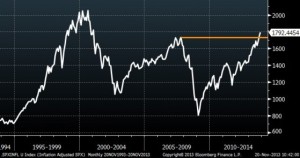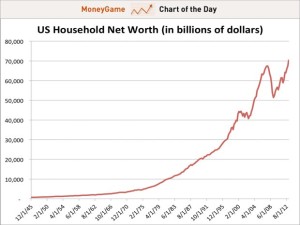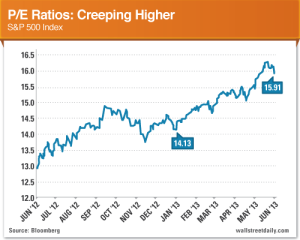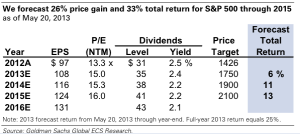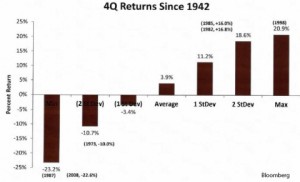The Paris-based World Federation of Exchanges (WFE), an association of 58 publicly regulated stock market exchanges around the world, recently released updated data on its monthly measure of the total market capitalization of the world’s major equity markets through the end of October. Here are some highlights:
1. As of the end of October, the total value of equities in those 58 major stock markets reached $62.64 trillion. That was just slightly below the all-time record monthly high of $62.77 trillion for global equity valuation in October 2007, several months before the global economic slowdown and financial crisis started, and caused global equity values to plummet by more than 50% (and by almost $34 trillion), from $62.8 trillion at the end of 2007 to only $29.1 trillion by early 2009 (see chart above).
2. Global equities gained almost $2 trillion in value during the month of October, and increased by 3.2% from September.
3. Compared to a year earlier, October’s world stock market capitalization increased by 19.6%, led by a 22.2% gain in the Europe-Africa-Middle East region, followed by gains of 20.8% in the Americas and 15.4% in the Asia-Pacific region.
4. By individual country, the largest year-over-year gains for October were recorded in Greece (118%), Ireland (53.2%), Bermuda (47.3%), the UAE (40.4%) and Taiwan (37.3%). In the US, the NYSE capitalization increased by 25.7% and the NASDAQ by 27.2%. The biggest losses in equity value over the last year were posted in Peru (-15.9%), Turkey (-14.5%) and Cyprus (-14.5%).
Compared to the recessionary low of $29.1 trillion in February 2009, the total world stock market capitalization more than doubled (115.3% increase) to the current level of $62.64 trillion, recapturing almost all of the global equity value that was lost due to the severe global recession and the various financial, mortgage and housing crises in 2008 and 2009. The global stock market rally over the last five years has added back more than $33.5 trillion to world equity values since 2009, and demonstrates the incredible resiliency of economies and financial markets to recover and prosper, even following the worst financial crisis and global economic slowdown in generations.
U.S. household debt climbed 1.1 percent during the third quarter as borrowing for mortgages, education, car purchases and on credit cards all increased, according to a Federal Reserve Bank of New York survey.
Consumer indebtedness rose $127 billion to $11.28 trillion, the biggest increase since the first quarter of 2008, according to a quarterly report on household debt and credit released today by the Fed district bank. Mortgage balances climbed $56 billion, student loans increased $33 billion, auto loans were up $31 billion and credit-card debt rose by $4 billion.
“We observed an increase of household balances across essentially all types of debt,” Donghoon Lee, senior research economist at the New York Fed, said in a statement. “With non-housing debt consistently increasing and the factors pushing down mortgage balances waning, it appears that households have crossed a turning point in the deleveraging cycle.”
Americans have slashed their debt from a peak of $12.68 trillion in the third quarter of 2008, according to the New York Fed.
Delinquency rates continued to drop in the third quarter, with 7.4 percent of outstanding debt in “some stage of delinquency,” down from 7.6 percent in the second quarter, the New York Fed said. There were about 355,000 new bankruptcies during the period, about the same as in the comparable timeframe in 2012.
There is no evidence that the Federal Reserve’s massive bond-buying effort has led U.S. stock prices higher, according to a report released on Wednesday by the economics research arm of McKinsey & Company. Instead, study co-authors Richard Dobbs and Susan Lund found that the biggest impact of quantitative easing by the world’s major central banks has been the cost-savings delivered to governments. Since 2007, bond-buying programs in the United States, the UK and the euro zone have reduced costs for governments by a total of $1.6 trillion. The finding will come as a surprise to many investors who attribute the rise in stock prices in the United States and elsewhere since the 2007-2009 financial crisis at least in part to easy central bank policies. All told, major central banks have added $4.7 trillion to their balance sheets over the past five years in an effort to push down long-term borrowing costs while keeping short-term interest rates low. The findings are sure to resonate among central bankers as they debate when and how fast they may be able to scale down the monetary stimulus they have used to keep deflation at bay and try and pull ravaged economies from the depths of recession.
While the entire study is over 70 pages long, the rather counter-intuitive findings regarding QE and stock prices can be found on pages 32-36 of the PDF:
The impact of ultra-low rate monetary policies on financial asset prices is ambiguous. Bond prices rise as interest rates decline, and, between 2007 and 2012, the value of sovereign and corporate bonds in the United States, the United Kingdom, and the Eurozone increased by $16 trillion. But we found little conclusive evidence that ultra-low interest rates have boosted equity markets. Although announcements about changes to ultra-low rate policies do spark short-term market movements in equity prices, these movements do not persist in the long term. Moreover, there is little evidence of a large-scale shift into equities as part of a search for yield. Price-earnings ratios and price book ratios in stock markets are no higher than long-term averages.
New figures announced
The Social Security Administration (SSA) has announced that Social Security and SSI beneficiaries will receive a 1.5% cost-of-living (COLA) adjustment for 2014. According to the SSA’s announcement, after the COLA adjustment, the estimated average retirement benefit will rise from $1,275 in 2013 to $1,294 in 2014.
The Centers for Medicare & Medicaid Services (CMS) has also announced next year’s Medicare costs. The standard monthly Medicare Part B premium will be $104.90 in 2014, the same as in 2013. However, beneficiaries with higher incomes (individuals with taxable incomes of more than $85,000 and couples with taxable incomes of more than $170,000) will pay more than $104.90 per month because they must pay an income-related surcharge.
Other important Social Security and Medicare figures are listed below.
- The amount of taxable earnings subject to the Social Security tax (called the maximum taxable earnings limit) will increase to $117,000 from $113,700 in 2013.
- The annual retirement earnings test exempt amount for beneficiaries under full retirement age will increase to $15,480 from $15,120 in 2013. If a beneficiary has earnings that exceed the exempt amount, $1 in benefits will be withheld for every $2 in earnings above the exempt amount.
- The annual retirement earnings test exempt amount that applies during the year a beneficiary reaches full retirement age will increase to $41,400 from $40,080 in 2013. If a beneficiary has earnings that exceed this amount, $1 in benefits will be withheld for every $3 in earnings above the exempt amount.
- The amount of earnings needed to earn one Social Security credit will increase to $1,200 from $1,160 in 2013.
- The Medicare Part B deductible will be $147, the same as in 2013.
- The monthly Medicare Part A premium for those who need to buy coverage will cost up to $426, down from $441 in 2013. However, most people don’t pay a premium for Medicare Part A.
- The Medicare Part A deductible for inpatient hospitalization will be $1,216, up from $1,184 in 2013. Beneficiaries will pay an additional daily co-insurance amount of $304 for days 61 through 90, up from $296 in 2013, and $608 for stays beyond 90 days, up from $592 in 2013.
- Beneficiaries in skilled nursing facilities will pay a daily co-insurance amount of $152 for days 21 through 100 in a benefit period, up from $148 in 2013.
According to preliminary data from the 2013 NACUBO-Commonfund Study of Endowments, U.S. educational endowments returned an average of 11.7% net of fees in the fiscal year ended June 30, 2013., which is a significant improvement over the -0.3% return in the prior fiscal year. The average 3 year trailing return as of June 30 was 10.4% for the 206 surveys received to date, while the average five-year trailing return was 4.3% and 7.1% for the 10-year period. Returns are net of fees and annualized.
Source: Pensions & Investments

